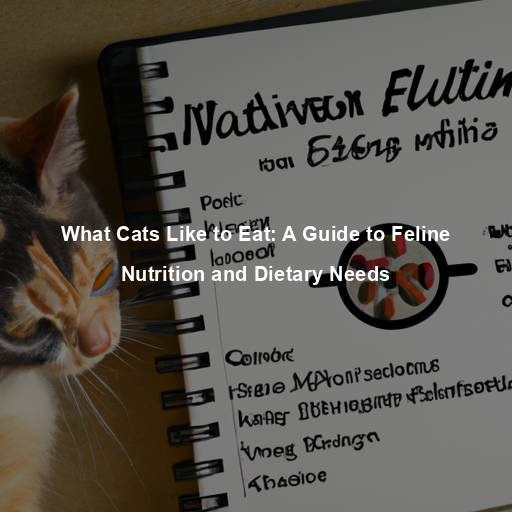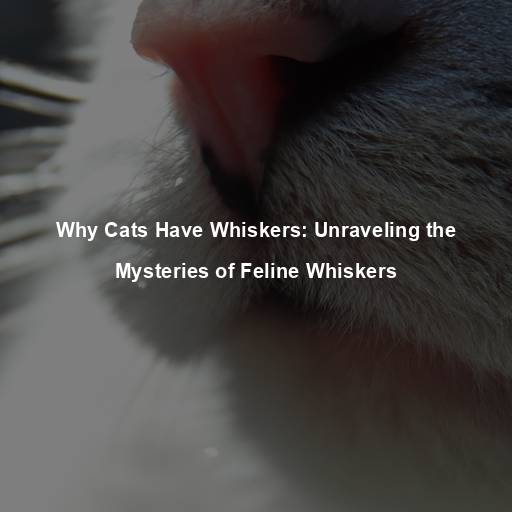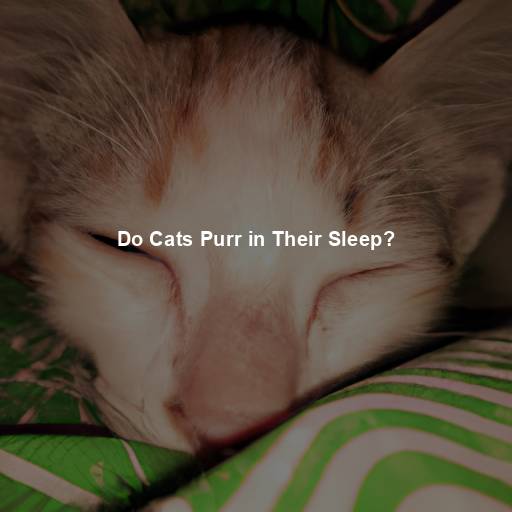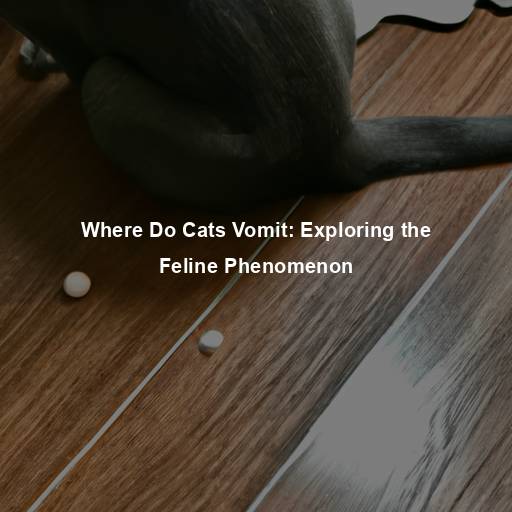What Cats Like to Eat: A Guide to Feline Nutrition and Dietary Needs
Last Updated on July 27, 2023 by Evan
Contents
- 1 Understanding a Cat’s Nutritional Requirements
- 2 Commercial Cat Food Options
- 3 Understanding Cat Food Labels
- 4 Feeding Guidelines for Cats
- 5 The Importance of Water
- 6 The Role of Treats
- 7 Choosing the Right Cat Food: Factors to Consider
- 8 FAQs – What Cats Like to Eat
- 8.1 What kind of food do cats like to eat?
- 8.2 Should I feed my cat only dry food?
- 8.3 Can I give my cat human food as treats?
- 8.4 Are there any fruits or vegetables that cats can eat?
- 8.5 Can I feed my cat milk?
- 8.6 Is a raw diet suitable for cats?
- 8.7 How often should I feed my cat?
- 8.8 What about water?
Understanding a Cat’s Nutritional Requirements
Cats, those captivating creatures that never cease to amaze us with their mysterious ways. Their independence and refined preferences set them apart from other pets. As caretakers, it is our duty to navigate the perplexing world of feline nutrition, ensuring our whiskered friends receive the nourishment they need to flourish. Unraveling the enigma of their specific dietary needs is the key to feeding them the perfect blend of sustenance and satisfaction.
The Obligate Carnivores
Cats are obligate carnivores, which means their bodies have evolved to require a diet that consists primarily of animal-based protein. Unlike omnivores or herbivores, cats have specific dietary needs that cannot be met through a plant-based diet alone. This is due to their inability to produce certain essential nutrients, such as taurine, which are vital for their overall health.
Essential Nutrients for Cats
To keep our cats healthy and happy, it is crucial to provide them with a diet that is rich in essential nutrients. Here are some key nutrients that cats require:
-
Protein: As obligate carnivores, cats need high levels of quality animal protein to thrive. Protein is essential for muscle development, tissue repair, and overall growth.
-
Taurine: Cats cannot synthesize taurine on their own and must obtain it through their diet. Taurine plays a vital role in maintaining healthy eyesight, heart function, and reproductive health.
Discover the vital role that fatty acids play in maintaining the lusciousness of your pet’s fur, nurturing their skin to radiance, and bolstering their immune system. Dive into the world of omega-3 and omega-6 fatty acids, as we unravel the perplexing wonders they bring to your furry friend’s well-being. Unleash the secrets behind sustaining a glossy coat, promoting skin health, and fortifying their resilience from within through the power of these essential nutrients.
Cats, like majestic feline beings, have a captivating need for a diverse palette of essential vitamins and minerals. From the regal vitamin A to the powerful vitamin D, their noble bodies rely on a delicate balance of calcium and phosphorus for the fortress of strong bones and enchanting teeth. These mythical nutrients weave their magic, bestowing upon our furry companions a mighty shield of immune resilience, like a secret potion that sustains their wellness.
Commercial Cat Food Options
Choosing the right cat food can be overwhelming, given the vast array of options available in the market. However, it is essential to select a cat food that meets the nutritional requirements of your feline companion. Here are some common types of commercial cat food:
Dry Cat Food
Dry cat food, also known as kibble, is a popular choice due to its convenience and affordability. It typically contains a combination of animal protein, carbohydrates, fats, vitamins, and minerals. However, it is important to note that cats have a low thirst drive and may not consume enough water when fed a dry food diet exclusively. Therefore, it is crucial to ensure that fresh water is always available.
Wet Cat Food
For feline enthusiasts seeking to bestow their beloved furballs with optimum hydration and gastronomic satisfaction, behold the wonders of wet cat food, the ethereal elixir swathed in tantalizing textures and mesmerizing flavors. Rendered with a luxuriously higher moisture content, this culinary marvel transcends the realm of mere sustenance and ventures into the realm of feline enigma. Inducing perplexity in the hearts of even the most discerning whisker connoisseurs, its exquisite composition of top-tier animal protein beckons to those requiring an oasis for their finicky palates.
Raw or Homemade Diets
For pet enthusiasts seeking alternative diets for their feline friends, the allure of raw or homemade meals can be captivating. Advocates argue that these diets mimic the natural sustenance cats would find in the wild – a tantalizing prospect indeed. Packed with raw meat, organs, and bones, coupled with meticulously selected supplements to ensure nutritional equilibrium, these diets have garnered a loyal following. Nonetheless, it is imperative to tread with caution and consult professionals such as veterinarians or feline nutritionists to guarantee the optimal formulation and fulfillment of your cat’s dietary requirements.
Understanding Cat Food Labels
Decoding the enigmatic hieroglyphics printed on cat food labels can be an overwhelming task for discerning pet owners yearning to nourish their feline friends adequately. Fear not, for colossal revelations await those who embark on this perplexing adventure. Behold, discerning reader, four critical factors to consider whilst scrutinizing these cryptic culinary proclamations: the ingredients list, guaranteed analysis, nutritional adequacy statement, and feeding guidelines. Unravel the riddles, unlock the secrets, and embark upon a labyrinth of enlightenment, ensuring the vitality of your cherished feline companion.
AAFCO Statement
The Association of American Feed Control Officials (AAFCO) sets the standards for pet food and determines whether a particular food is complete and balanced for a specific life stage. Look for an AAFCO statement on the label, indicating that the food has undergone feeding trials or meets the nutritional profiles established by AAFCO.
Ingredient List
The ingredient list provides valuable insights into the composition of the cat food. Look for high-quality animal protein sources, such as chicken, turkey, or fish, listed as the primary ingredients. Avoid foods that contain excessive fillers, by-products, or artificial additives.
Guaranteed Analysis
As a conscientious pet owner, it’s essential to have a good grasp on the guaranteed analysis section of your cat food label. This section provides valuable insight into the levels of vital nutrients, like protein and taurine, that your feline friend needs. By ensuring that these levels meet the minimum requirements, you can ensure that your cat’s nutritional needs are being met with each delicious bite.
Feeding Guidelines for Cats
Determining the right amount of food to feed your feline friend can be quite the conundrum. With various factors like age, weight, activity level, and overall health playing a role, it’s no wonder pet parents find themselves in a state of bewilderment. To navigate this perplexing puzzle, it’s best to seek the wisdom of a veterinarian who can provide tailored advice on portion sizes and feeding frequency. While we can offer some general guidelines to help you along the way, remember that each cat is unique, and consulting with a professional will ensure your furry companion receives the nourishment they need.
Breaking news: Attention all cat lovers! If you’ve been lucky enough to bring a bundle of furry joy into your home, get ready for an adorably perplexing adventure. These pint-sized felines, oh-so cutely known as kittens, are bursting with energy and growing at warp speed. With this rapid growth in mind, it’s crucial to provide them with a diet that caters to their specific needs.
Feeding your adult cat may seem like a puzzle, with varying portion sizes and individual needs adding intrigue to the mix. Twice-daily meals are the norm, but the real conundrum lies in deciphering the perfect portion. Keep a watchful eye on your feline companion’s body condition, and let it guide you in unraveling the ideal amount, ensuring a healthy weight for your enigmatic furball.
As our feline friends gracefully age, we notice a shift in their vitality and playfulness. It’s important to acknowledge that their metabolic rate tends to decelerate during this phase, possibly causing them to become less energetic. To ensure their well-being, it’s crucial to adapt their portion sizes and ponder the idea of transitioning them to a specialized formula designed for senior cats. By addressing their evolving nutritional requirements, we can provide our senior companions with the nourishment they need to thrive in their golden years.
The Importance of Water
Water is a vital component of a cat’s diet and plays a crucial role in maintaining overall health. Cats have a low thirst drive, which can make them prone to dehydration, especially if they are fed a dry food diet exclusively. Here are some tips to encourage your cat to drink more water:
One of the key elements to maintaining a healthy and comfortable living environment is the continuous availability of fresh and clean water. It is imperative to have various accessible water sources strategically placed in different areas of your home. By ensuring this, you can alleviate any concerns and guarantee easy access to proper hydration, whether it be for drinking, cooking, or hygiene purposes.
If you’re a feline aficionado looking to enhance your furry friend’s hydration habits, perhaps it’s time to ponder the purrfect addition to your household – a cat water fountain. These ingeniously crafted contraptions not only quench the thirst of our beloved whiskered companions but also add an element of curiosity and whimsy to their daily routines. With the mesmerizing allure of flowing water, these fountains may just be the answer to entice those finicky felines who prefer their ##O in motion. So why not dare to dabble in the mysterious depths of cat water fountain wonderment?
– Mix wet food with water to increase their overall water intake.
Ensuring your furry friends stay properly hydrated at all times can sometimes be a bit of a head-scratcher. Why not try sprinkling your living space with an array of water bowls? By strategically placing multiple water sources throughout different corners of your abode, you’ll keep your beloved pets guessing and add some excitement to their daily hydration routine. So go ahead, embrace the unexpected and bewilder your four-legged companions with a delightful array of watering stations!
The Role of Treats
Treats can be a fun way to bond with your cat and provide them with additional enrichment. However, it is important to use treats in moderation and ensure that they do not exceed 10% of your cat’s daily caloric intake. Opt for high-quality treats that are specifically formulated for cats and avoid human foods that can be toxic to them.
Myth 1: Cats Can Thrive on a Vegetarian Diet
There seems to be a prevailing misconception floating around that cats can blissfully exist on a vegetarian or vegan diet. But let’s unravel this web of confusion and delve into the truth. Cats, my feline-loving friends, are, by nature, obligate carnivores who vehemently require certain nutrients that can only be sourced from animals themselves. We’re talking about taurine, arachidonic acid, and the oh-so-vital vitamin A, to name just a few.
Myth 2: Milk is Good for Cats
Contrary to popular belief, milk is not a suitable beverage for adult cats. While kittens may benefit from their mother’s milk during early development, most cats become lactose intolerant as they grow older. Feeding milk or dairy products to adult cats can lead to digestive upset, including diarrhea and stomach discomfort. It is best to offer cats fresh water as their main source of hydration.
Myth 3: Raw Meat is Always Safe for Cats
As cat owners, we often ponder over the best diet to keep our feline friends healthy and happy. While the allure of a raw meat diet may seem enticing, it is crucial to navigate the labyrinth of potential risks lurking in this culinary realm. Beyond the sheer burst of flavors, raw meat can harbor unruly bacteria like Salmonella or E. coli, which may comically wreak havoc on the delicate balance of health for both our beloved kitties and their human caregivers. It is perplexing to fathom the complexity involved in maintaining a nutritional equilibrium, ensuring that our cats receive all the vital nutrients they need.
Myth 4: Cats Need a Grain-Free Diet
In a world where feline diets are constantly evolving, the rise of grain-free eating for cats has sparked both fascination and confusion among pet owners. While the notion of keeping grains away from their fur babies seems instinctual, recent studies reveal a perplexing truth. Contrary to the popular belief, grains may not be the villain they were made out to be. In fact, grains can offer cats a nourishing array of essential nutrients like invaluable carbohydrates, fiber, and those elusive essential fatty acids.
Myth 5: Homemade Diets Are Always Better
When it comes to treating our feline friends to a homemade meal, we need to tread cautiously through the labyrinth of nutritional complexities. While the idea may seem enticing, let’s not forget the jigsaw puzzle of specific dietary requirements that our cats possess. Engaging the expert opinions of veterinarians or feline nutritionists can unravel the confusion surrounding formulating a nutritionally balanced diet for our purring pals. Without their guidance, we may be unwittingly setting our cats up for a perilous path of nutrient deficiencies and imbalances, jeopardizing their long-term health.
Choosing the Right Cat Food: Factors to Consider
Choosing the right cat food can feel like navigating a labyrinth of perplexing choices. Yet, rest assured that your feline companion’s well-being lies in the careful selection of their daily sustenance. Take into account vital factors such as their age, breed, and specific dietary requirements to ensure an optimal balance of nutrients. By unraveling the endless options with a discerning eye, you can provide the nourishment your furry friend deserves, keeping them vibrant and full of life.
Life Stage
Cats have different nutritional requirements at various stages of life, including kittenhood, adulthood, and senior years. Choose a cat food formula that is specifically formulated for your cat’s life stage to ensure they receive the appropriate balance of nutrients.
Quality Ingredients
When it comes to nourishing our feline friends, it’s important to prioritize cat foods that boast top-notch animal protein sources as their star ingredients. Steer clear of products that are brimming with fillers, by-products, or artificial additives—keeping things au naturel is the key. By taking a closer look at the ingredient list and grasping the benefits each component brings to the table, we can make choices that are both wise and well-informed.
Nutritional Adequacy
When it comes to choosing the purrfect cat food, one thing you don’t want to miss is scanning the label for the prestigious AAFCO statement. This little declaration assures that the food has passed rigorous feeding trials or meets the well-established nutritional profiles set by AAFCO. In simpler terms, it ensures that your beloved feline friend gets all the essential nutrients in a well-rounded meal. So, keep an eye out for that beautifully reassuring stamp of approval!
Individual Needs
When it comes to taking care of your feline friend, it’s crucial to take into account their unique dietary requirements and individual sensitivities. It’s not uncommon for cats to have specific nutritional demands related to allergies, sensitivities, or existing health issues. Seeking guidance from a trusted veterinarian can provide you with invaluable insights and assist you in selecting the most suitable diet for your beloved cat.
Personal Preference
Every cat is unique, and their taste preferences may vary. Consider your cat’s individual likes and dislikes when selecting cat food. Offering a variety of flavors and textures can help keep mealtime exciting for your feline companion.
FAQs – What Cats Like to Eat
What kind of food do cats like to eat?
When it comes to feline nutrition, the truth is as clear as a crystal bowl of milk. Cats, my dear readers, are what we call “obligate carnivores.” Fancy term, yes, but it simply means these little furballs have an undeniable penchant for feasting on meat. Their bodies crave the exquisite blend of high-quality animal proteins to thrive and maintain their overall well-being. Luckily, the market offers a wide array of commercial cat food that has been meticulously crafted to meet all their nutritional needs. So, why not treat your whiskered companion to a feast fit for a king?
Should I feed my cat only dry food?
While dry food can be a convenient option, it is generally recommended to provide a combination of both dry and wet food in a cat’s diet. Wet food not only helps to ensure proper hydration but also tends to be more palatable for most cats. The moisture content in wet food can be beneficial for urinary tract health as well.
Can I give my cat human food as treats?
While some human foods are safe for cats in moderation, it is important to be cautious and avoid certain foods that can be harmful to them. Foods like onions, garlic, chocolate, caffeine, grapes, raisins, and alcohol are toxic to cats and should never be given to them. It is best to provide specially formulated cat treats to ensure your furry friend’s safety and nutrition.
Are there any fruits or vegetables that cats can eat?
When it comes to a feline’s diet, their carnivorous nature takes the center stage, leaving little room for fruits and vegetables. However, don’t dismiss these plant-based goodies entirely, as they can still play a supporting role. Think of cooked carrots, peas, pumpkin, and a sprinkle of berries as their occasional co-stars. Just remember to introduce these new food items gradually and keep a watchful eye on how your cat responds to their unconventional culinary delights.
Can I feed my cat milk?
Contrary to popular belief, most adult cats are lactose intolerant and lack the necessary enzymes to digest milk properly. Feeding them milk can lead to gastrointestinal upset and diarrhea. If you want to offer a dairy treat, there are lactose-free cat milk options available in pet stores that are specifically formulated for cats’ digestive systems.
Is a raw diet suitable for cats?
Feeding raw food to cats is a controversial topic. It is important to recognize that raw diets can pose health risks, both for the cat and the owner, due to the potential presence of pathogens. If you choose to feed your cat a raw diet, it is crucial to consult with a veterinarian to ensure a balanced and nutritionally complete diet that meets all of their specific needs.
How often should I feed my cat?
Determining how often to feed your beloved feline can be a perplexing task, as it hinges upon various factors such as age, health, and personal preferences. Delving into the realm of kittens and expectant or nursing cats, it is advisable to provide them with petite, intermittent meals throughout the day. On the other hand, adult cats tend to thrive on a regimen of 2-3 nourishing meals daily. Striking the right balance is crucial, lest we succumb to the temptation of overfeeding and jeopardize our furry companion’s well-being.
What about water?
It’s no secret that cats can be quite finicky when it comes to their water intake. While it’s essential to provide them with fresh water at all times, it’s equally crucial to consider their unique preferences. Some felines crave the mesmerizing flow of a cat water fountain, while others prefer a bit of distance between their water bowl and food. To ensure optimal hydration, be sure to diligently clean and refill their water bowl to keep it enticingly pristine. Your feline companion’s health and well-being depend on it!







